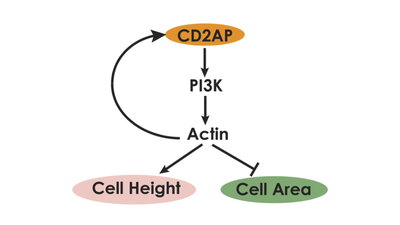
Many epithelial tissues are classified as being squamous, cuboidal, or columnar based upon the height of their lateral membranes. CDB researchers Yuou Wang and Bill Brieher identified a protein known as CD2AP as a key factor necessary for building up the lateral membrane.
Kidney epithelial cells depleted of CD2AP become very thin and convert from their normal cuboidal morphology to a squamous morphology. CD2AP binds to both actin filaments, which are used to physically organize cells, as well as PI-3-Kinase, which phosphorylates a lipid to send various signals to the cell. Both actin and PI-3-Kinase depend on CD2AP function while actin organization depends on PI-3-Kinase and vice versa. The results suggest the existence of a positive feedback loop in which CD2AP links actin polymer assembly to PI-3-Kinase activation which in turn triggers more actin assembly to build up the lateral membrane. Interesting questions for the future are to know if this same signaling pathway can be modulated to dial in the height of the lateral membrane to generate squamous versus cuboidal versus columnar epithelial tissue and whether mutations in CD2AP that cause inherited kidney disease affect cell height.

